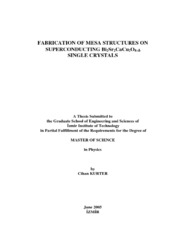Please use this identifier to cite or link to this item:
https://hdl.handle.net/11147/3216Full metadata record
| DC Field | Value | Language |
|---|---|---|
| dc.contributor.advisor | Özyüzer, Lütfi | en |
| dc.contributor.author | Kurter, Cihan | - |
| dc.date.accessioned | 2014-07-22T13:51:06Z | - |
| dc.date.available | 2014-07-22T13:51:06Z | - |
| dc.date.issued | 2005 | en |
| dc.identifier.uri | http://hdl.handle.net/11147/3216 | - |
| dc.description | Thesis (Master)--Izmir Institute of Technology, Physics, Izmir, 2005 | en |
| dc.description | Includes bibliographical references (leaves: 109-114) | en |
| dc.description | Text in English; Abstract: Turkish and English | en |
| dc.description | xii, 114 leaves | en |
| dc.description.abstract | There have been tremendous efforts to understand the relatively much more sophisticated mechanism of superconductivity in high temperature superconductors (HTSC). In order to investigate the inherent features and tunneling characteristics just only peculiar to HTSC, micron-sized mesa structures were fabricated on the surfaces of both pristine optimally doped and HgBr2 intercalated Bi2Sr2CaCu2O8+& (Bi-2212) single crystals using photolithography and Argon ion beam etching techniques. The surface topography and heights of the mesas were examined with atomic force microscopy.Hysteretic I-V curves with multiple branches and temperature dependence of tunneling characteristics were investigated by means of a novel technique, point contact tunneling (PCT) and experiments were carried out in a large range of temperatures from 4.2 K to 300 K. The results of SIN single junctions and SIS break junctions obtained by tunneling measurements using PCT technique on bulk crystals were compared withtunneling measurements using PCT technique on bulk crystals were compared with intrinsic Josephson junction quasiparticle spectra generally showing sharp peaks at the gap voltages and no dip/hump structures; which are reconciled with overheating in the mesa. The IJJ measurements performed with HgBr2 intercalated Bi-2212 samples showed far more enhanced characteristics indicating less heating. The zero bias conductance versus temperature plots were examined to scrutinize the existence of pseudogap in electronic excitation spectra of investigated samples. Besides, the normalized gap voltages were plotted against normalized temperature to show the deviation from BCS fit, which displays the novelty of HTSC. | en |
| dc.language.iso | en | en_US |
| dc.publisher | Izmir Institute of Technology | en |
| dc.rights | info:eu-repo/semantics/openAccess | en_US |
| dc.subject.lcc | QC611.98.H54 .K96 2005 | en |
| dc.subject.lcsh | High temperature superconductors | en |
| dc.title | Fabrication of mesa structures on superconducting Bi2Sr2CaCu2O8+& single crystals | en_US |
| dc.type | Master Thesis | en_US |
| dc.institutionauthor | Kurter, Cihan | - |
| dc.department | Thesis (Master)--İzmir Institute of Technology, Physics | en_US |
| dc.relation.publicationcategory | Tez | en_US |
| item.languageiso639-1 | en | - |
| item.fulltext | With Fulltext | - |
| item.openairecristype | http://purl.org/coar/resource_type/c_18cf | - |
| item.openairetype | Master Thesis | - |
| item.grantfulltext | open | - |
| item.cerifentitytype | Publications | - |
| Appears in Collections: | Master Degree / Yüksek Lisans Tezleri | |
Files in This Item:
| File | Description | Size | Format | |
|---|---|---|---|---|
| T000346.pdf | MasterThesis | 25.48 MB | Adobe PDF |  View/Open |
CORE Recommender
Page view(s)
124
checked on Jul 22, 2024
Download(s)
84
checked on Jul 22, 2024
Google ScholarTM
Check
Items in GCRIS Repository are protected by copyright, with all rights reserved, unless otherwise indicated.